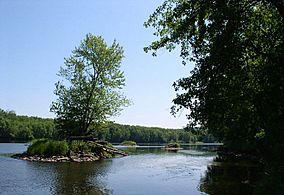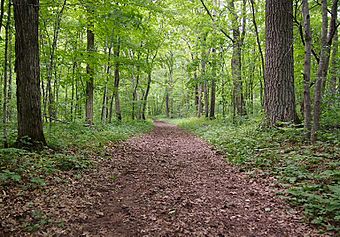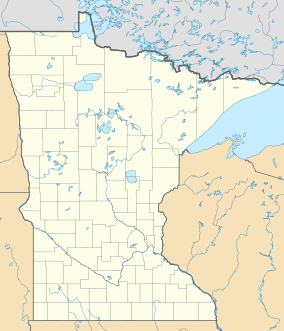Wild River State Park facts for kids
Quick facts for kids Wild River State Park |
|
|---|---|

Wild River State Park protects shoreline along the St. Croix, a National Wild and Scenic River
|
|
| Location | Chisago, Minnesota, United States |
| Area | 6,574 acres (26.60 km2) |
| Elevation | 774 ft (236 m) |
| Established | 1973 |
| Governing body | Minnesota Department of Natural Resources |
|
Point Douglas to Superior Military Road: Deer Creek Section
|
|

Park trail following the route of the Point Douglas to Superior Military Road
|
|
| Location | Amador Township |
|---|---|
| Area | 2.2 acres (0.9 ha) |
| Built | 1853 |
| Architect | James Hervey Simpson (engineer), John Rollins (builder) |
| Architectural style | earth road |
| MPS | Minnesota Military Roads, 1850–1857 |
| NRHP reference No. | 90002200 |
| Added to NRHP | 1991-02-07 |
Wild River State Park is a cool state park in Minnesota, United States. It stretches for about 18 miles (29 km) along the beautiful St. Croix River. This park is long and narrow, shaped a bit like a sideways 'S'. Most of the park's main areas are in the lower part. The quieter, upper sections are near where the Sunrise River flows into the St. Croix. This park is designed for peaceful, nature-focused fun, unlike some busier parks downstream.
Wild River State Park gets its name because the St. Croix River is a special National Wild and Scenic River. This means it's protected for its natural beauty. Inside the park, you can also find a piece of history: the Point Douglas to Superior Military Road: Deer Creek Section. This old road was built in 1853 and is so important that it's listed on the National Register of Historic Places.
Park's Natural Wonders
How the Land Was Formed
The ground beneath Wild River State Park was made by volcanoes! About 1.1 billion years ago, hot basalt rock flowed here. On top of that, there's a thick layer of rock and dirt left behind by giant glaciers. About 16,000 years ago, during the Wisconsin glaciation (a big ice age), a huge ice sheet blocked rivers. This created a giant lake called Glacial Lake Grantsburg. The soil in the park is very sandy because of all the sand that settled in this ancient lake.
When the ice age ended about 10,000 years ago, melting water from another huge lake, Glacial Lake Duluth, carved out the St. Croix River Valley. Today, the river is much smaller than it was back then. You can still see the old riverbank, which is a bluff running through the park, far from where the river flows now.
Plants and Animals of the Park
Originally, this area was a mix of different types of forests and open grasslands. There were pine forests, hardwood forests, and oak savannas. But logging and farming changed these habitats. Today, the park has a mix of newer forests and open meadows.
Since the river can flood in spring, you'll find trees like silver maple and basswood that like wet feet. There are also wetlands scattered around the park. If you walk the trails, you'll see lots of berries and wild roses. Different wildflowers bloom every month from spring to summer. In spring, look for wild columbine and wild geranium. In summer, you might spot black-eyed Susan and butterfly milkweed. Fall brings beautiful asters and goldenrods. The park also has native grasses like big bluestem and Indian grass.
Helping Nature Grow: Prairie Care and Buckthorn-Free Zones
The park is working hard to bring back its original oak savanna and prairie areas through the Prairie Care Project. This involves carefully burning parts of the land to help new plants grow and removing pine trees that farmers planted long ago. You can even volunteer to help collect seeds in the fall and plant them in the spring!
Another project is the Buckthorn-Free Zone. This aims to get rid of buckthorn, a plant that isn't native to the area and can harm other plants. Volunteers can "adopt" a part of the park and work to remove buckthorn from it.
Wildlife in the Park
Even though the park is narrow, it's an important path for many birds migrating north and south along the St. Croix River. You might see beavers, raccoons, river otters, foxes, coyotes, squirrels, minks, and white-tailed deer. More and more black bears are being seen too! Ducks, herons, and bitterns love the wetlands. The park has a list of 200 different bird species that visit throughout the year.
Park's Past: A Journey Through Time
Early Days and Trading Posts
People have lived in this area for a very long time. Scientists have found old tools and items in the park that are 5000 years old! Most of the artifacts found are from 1200 to 500 years ago. An ancient village site has been found near where the Sunrise River meets the St. Croix. Later, in 1847, a fur trading post was built right on top of this old village. These trading posts were some of the last ones in the St. Croix Valley and only operated for a few years.
In the 1850s, towns like Sunrise, Amador, and Almelund were started. There was even a town called Nashua that was sold on paper, but it was actually just a marsh and never really existed!
The Old Military Road
In the 1850s, the government started building the Point Douglas to Superior Military Road. This road was meant for soldiers to travel, but it became one of the first major roads in the area. It connected Hastings, Minnesota to Superior, Wisconsin and was used by many people and businesses. When Minnesota became a state in 1858, it took over the road but didn't have enough money to finish it. Even though it was rough, this road was the best way to travel north until railroads were built in 1870.
A 1.2-mile (1.9 km) part of this old road is still in the park today and is part of the park's hiking trails! You can find it just south of Deer Creek. It forms part of the Deer Creek Loop trail along the St. Croix River.
Logging and the Nevers Dam
After a treaty with the Ojibwe people in 1837, the area (including the park) was opened for logging. Loggers were especially interested in the huge Eastern White Pine trees, which could grow up to 200 feet (61 m) tall! Cut trees were floated down the St. Croix River to sawmills in Stillwater.
Sometimes, huge log jams would happen on the river. The 1883 jam, near Angle Rock, was the biggest log jam in the world! It took 57 days to clear, and one sawmill even went out of business because of it. To stop these jams, the Nevers Dam was built here in 1889–90. This dam helped control the flow of logs. It created a 10-mile (16 km) lake where logs could be gathered safely. Gates were opened every two weeks to send a steady supply of wood to Stillwater. These batches of logs could be up to a mile and a half long! You can still see a 600-foot-long (180 m) dirt wall that was built to keep the reservoir from overflowing.
By 1902, most of the valuable timber in the park area was gone. The next year, Northern States Power (NSP) bought the dam to control the river's flow for a new hydroelectric dam they were building at St. Croix Falls. Log drives from farther upriver continued until 1912. In the 1940s, people started to dislike the dam because it affected recreation and nature. So, the gates were left open each summer. A big flood in 1954 damaged the Nevers Dam, and NSP removed it the next year.
How the Park Was Created
Northern States Power owned a lot of land along the river, including the area where Nevers Dam was. After their St. Croix Falls Dam was finished in 1907, they didn't really need this land 11 miles (18 km) upstream anymore. They talked about giving the land to the state as early as the 1930s.
However, it was the creation of the Saint Croix National Scenic Riverway in 1968 that really got things moving. The main problem was that Chisago County would lose a lot of property tax money if the land became a park. After some back and forth, the state park was finally approved in 1973. The state agreed to pay the county for some of the lost tax money for 10 years. NSP donated 4,497 acres (1,820 ha) of land, and federal money helped buy land from other owners. The Nature Conservancy also helped get property. The park started being developed in 1976 and opened two years later. It was first called St. Croix Wild River State Park, but the name was shortened to avoid confusion with St. Croix State Park.
Fun Things to Do at the Park
Wild River State Park has many options for staying overnight. The main campground has 94 spots for cars, and 34 of them have electricity. There are also six cozy camper cabins, showers, and flush toilets. A rustic horse campground has 20 sites (15 with electricity) but no showers. For groups, there's a primitive camp with vault toilets that can hold up to 18 people in nine sites.
If you love backpacking, there are seven campsites scattered throughout the park. Plus, there are four canoe campsites right along the St. Croix River. The park also has six camping cabins with bunk beds, a table, and benches. You can even rent a guesthouse with two bedrooms, a bathroom, and a full kitchen!
Trails and Activities
The park has 35 miles (56 km) of hiking trails. About 18 miles (29 km) of these trails are also open for horseback riding. There's a 2.6-mile (4.2 km) paved trail that connects the park's main areas, perfect for bikes, rollerblades, and wheelchairs. You can also explore two 1-mile (1.6 km) interpretive trails that teach you about the park. A trail shelter is open all year with modern restrooms and can be rented for events.
In winter, 30 miles (48 km) of trails are prepared for cross-country skiing and skate skiing. Another 6 miles (9.7 km) are groomed for snowshoeing. Snowshoers can go anywhere in the park, as long as they stay off the ski trails. The trail center is a warm place to relax in winter and offers ski and snowshoe rentals.
The McElroy Interpretive Center has cool exhibits and hosts nature programs all year. In the evenings, you can enjoy events at the amphitheater near the campground.
River Fun
The St. Croix River is a great place for canoeing. A company in the park rents canoes by the hour or day and can even shuttle you back from your take-out spot. There are boat ramps in the main part of the park and at the Sunrise access point. Just remember, jet skis are not allowed on this part of the river. If you like to fish, you can try to catch smallmouth bass, northern pike, walleye, and catfish in the river.



